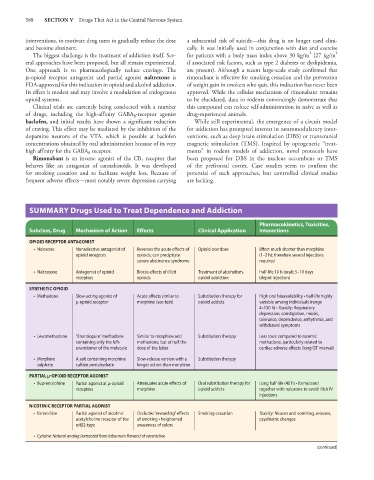Page 602 - Basic _ Clinical Pharmacology ( PDFDrive )
P. 602
588 SECTION V Drugs That Act in the Central Nervous System
interventions, to motivate drug users to gradually reduce the dose a substantial risk of suicide—this drug is no longer used clini-
and become abstinent. cally. It was initially used in conjunction with diet and exercise
2
2
The biggest challenge is the treatment of addiction itself. Sev- for patients with a body mass index above 30 kg/m (27 kg/m
eral approaches have been proposed, but all remain experimental. if associated risk factors, such as type 2 diabetes or dyslipidemia,
One approach is to pharmacologically reduce cravings. The are present). Although a recent large-scale study confirmed that
μ-opioid receptor antagonist and partial agonist naltrexone is rimonabant is effective for smoking cessation and the prevention
FDA-approved for this indication in opioid and alcohol addiction. of weight gain in smokers who quit, this indication has never been
Its effect is modest and may involve a modulation of endogenous approved. While the cellular mechanism of rimonabant remains
opioid systems. to be elucidated, data in rodents convincingly demonstrate that
Clinical trials are currently being conducted with a number this compound can reduce self-administration in naive as well as
of drugs, including the high-affinity GABA -receptor agonist drug-experienced animals.
B
baclofen, and initial results have shown a significant reduction While still experimental, the emergence of a circuit model
of craving. This effect may be mediated by the inhibition of the for addiction has prompted interest in neuromodulatory inter-
dopamine neurons of the VTA, which is possible at baclofen ventions, such as deep brain stimulation (DBS) or transcranial
concentrations obtained by oral administration because of its very magnetic stimulation (TMS). Inspired by optogenetic “treat-
high affinity for the GABA receptor. ments” in rodent models of addiction, novel protocols have
B
Rimonabant is an inverse agonist of the CB receptor that been proposed for DBS in the nucleus accumbens or TMS
1
behaves like an antagonist of cannabinoids. It was developed of the prefrontal cortex. Case studies seem to confirm the
for smoking cessation and to facilitate weight loss. Because of potential of such approaches, but controlled clinical studies
frequent adverse effects—most notably severe depression carrying are lacking.
SUMMARY Drugs Used to Treat Dependence and Addiction
Pharmacokinetics, Toxicities,
Subclass, Drug Mechanism of Action Effects Clinical Application Interactions
OPIOID RECEPTOR ANTAGONIST
• Naloxone Nonselective antagonist of Reverses the acute effects of Opioid overdose Effect much shorter than morphine
opioid receptors opioids; can precipitate (1–2 h); therefore several injections
severe abstinence syndrome required
• Naltrexone Antagonist of opioid Blocks effects of illicit Treatment of alcoholism, Half-life 10 h (oral); 5–10 days
receptors opioids opioid addiction (depot injection)
SYNTHETIC OPIOID
• Methadone Slow-acting agonist of Acute effects similar to Substitution therapy for High oral bioavailability • half-life highly
μ-opioid receptor morphine (see text) opioid addicts variable among individuals (range
4–130 h) • Toxicity: Respiratory
depression, constipation, miosis,
tolerance, dependence, arrhythmia, and
withdrawal symptoms
• Levomethadone “Enantiopure” methadone Similar to morphine and Substitution therapy Less toxic compared to racemic
containing only the left- methadone, but at half the methadone, particularly related to
enantiomer of the molecule dose of the latter cardiac adverse effects (long QT interval)
• Morphine A salt containing morphine Slow-release version with a Substitution therapy
sulphate sulfate pentahydrate longer action than morphine
PARTIAL l-OPIOID RECEPTOR AGONIST
• Buprenorphine Partial agonist at μ-opioid Attenuates acute effects of Oral substitution therapy for Long half-life (40 h) • formulated
receptors morphine opioid addicts together with naloxone to avoid illicit IV
injections
NICOTINIC RECEPTOR PARTIAL AGONIST
• Varenicline Partial agonist of nicotinic Occludes “rewarding” effects Smoking cessation Toxicity: Nausea and vomiting, seizures,
acetylcholine receptor of the of smoking • heightened psychiatric changes
α4β2-type awareness of colors
• Cytisine: Natural analog (extracted from laburnum flowers) of varenicline
(continued)

